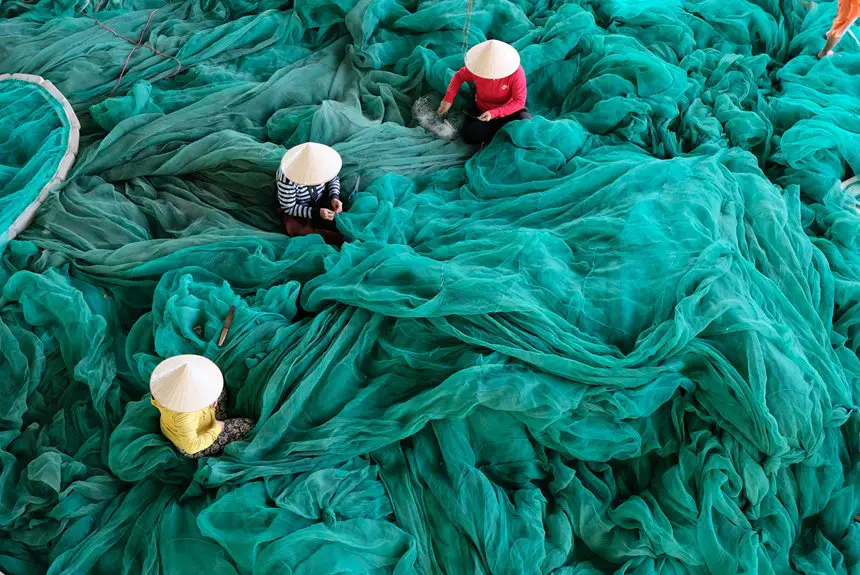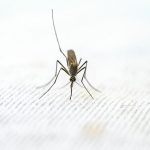You might think gauze fabric is good for mosquito netting because it’s lightweight and breathable, but its loose weave lets tiny insects through, making it less effective. It also tears easily and holds moisture, which can cause mold. Traditional nets use tighter, stronger materials like polyester or nylon for better protection and durability. If you want to understand why mesh size matters and what alternatives work best, keep exploring this topic.
Table of Contents
Key Takeaways
- Gauze’s loose weave allows air flow but is too open to block small mosquitoes effectively.
- Its softness and breathability provide comfort but compromise insect protection.
- Gauze fabric is fragile and prone to tearing, reducing its durability as netting.
- Moisture retention in gauze can lead to mold, weakening protection and hygiene.
- Synthetic meshes like polyester or nylon offer better insect barriers and durability than gauze.
Understanding the Characteristics of Gauze Fabric
Gauze fabric features an open weave that makes it lightweight and breathable. When you handle gauze, you’ll notice its loose texture allows plenty of air to pass through, which keeps you cool.
This openness, however, also means the holes between threads are relatively large. If you look closely, you can see the gaps are much bigger than what you’d find in tighter weaves like muslin or chambray.
Because of this, gauze is often used in medical settings for bandages or in fashion for airy clothing. Its softness and flexibility make it comfortable to wear or cover with.
Gauze’s softness and breathability make it ideal for comfortable bandages and lightweight clothing.
However, the open weave also means it mightn’t provide a solid barrier against very small insects, which is something to keep in mind when considering it for mosquito netting.
How Mosquito Netting Works to Prevent Bites
You’ll want to focus on the mesh size when choosing mosquito netting because it determines how well it blocks even the smallest insects.
At the same time, the material’s breathability matters since it keeps you comfortable while preventing bites.
Balancing these two factors helps you pick the most effective netting.
Mesh Size and Protection
Although mosquito netting may look simple, its effectiveness hinges on the size of the mesh openings. If the mesh is too large, mosquitoes can easily slip through, defeating the net’s purpose.
You want a mesh size small enough to block even the tiniest mosquitoes, typically around 1.2 millimeters or less. This tight weave acts as a physical barrier, preventing mosquitoes from getting close enough to bite you.
However, if the mesh is too dense, it might reduce airflow, but that’s a separate issue. For now, focus on choosing a net with the right mesh size to guarantee maximum protection.
Material Breathability Effects
Because mosquito netting needs to keep bugs out while allowing air to flow, material breathability plays a crucial role in its effectiveness.
You want a fabric that blocks mosquitoes but still lets air circulate, keeping you cool and comfortable. Gauze fabric’s breathability can impact how well it works as mosquito netting. Here’s why it matters:
- Airflow: Proper breathability lets you avoid stuffiness, making it easier to sleep under the net.
- Moisture control: Breathable fabric helps reduce sweat buildup, preventing discomfort and skin irritation.
- Mosquito detection: Good airflow allows you to sense if mosquitoes are trapped outside the net, alerting you to potential breaches.
Choosing a breathable material guarantees you stay protected without sacrificing comfort during warm nights.
Comparing Gauze to Traditional Mosquito Netting Materials
You’ll want to compare gauze with traditional mosquito netting materials by looking at durability, breathability, and protection.
Gauze tends to be softer and more breathable but may not hold up as well over time.
Understanding these differences helps you pick the best option for keeping mosquitoes out.
Material Durability Comparison
When comparing gauze fabric to traditional mosquito netting materials, you’ll notice significant differences in durability that affect long-term use.
Gauze tends to be more delicate, making it prone to tearing or fraying with frequent handling or outdoor exposure. Traditional netting, often made from polyester or nylon, typically withstands wear and environmental stress much better.
Consider these points:
- Tensile Strength: Traditional netting resists stretching and tearing, while gauze can weaken quickly under tension.
- Weather Resistance: Polyester and nylon nets handle moisture and sunlight without degrading fast; gauze may deteriorate or mold.
- Maintenance: Gauze requires gentle care to avoid damage, whereas traditional nets are easier to clean and dry quickly.
You’ll want to weigh these durability factors carefully when choosing mosquito netting.
Breathability and Protection
Although gauze fabric offers excellent breathability due to its loose weave, it often falls short in providing reliable protection against mosquitoes compared to traditional netting materials.
When you use gauze, the larger gaps let more air pass through, keeping you cool, but they also allow tiny insects to slip inside.
Traditional mosquito netting uses a tighter mesh that balances airflow with a strong barrier against even the smallest mosquitoes.
If you prioritize comfort and airflow, gauze might seem appealing, but it compromises safety.
On the other hand, standard netting guarantees you stay protected without sacrificing too much breathability.
The Importance of Mesh Size in Mosquito Netting
Mesh size plays an essential role in determining how effective mosquito netting will be at keeping insects out. If the mesh is too large, tiny mosquitoes can slip through, defeating the purpose.
Mesh size is crucial; too large, and mosquitoes sneak in, ruining the net’s effectiveness.
On the other hand, an excessively small mesh might restrict airflow, making it uncomfortable. When selecting mosquito netting, consider these factors:
- Hole Diameter: Choose a mesh size smaller than the smallest mosquito to guarantee no entry.
- Durability: Smaller meshes often mean tighter weaves, so check if the fabric can withstand wear and tear.
- Functionality: Make certain the mesh size balances protection with usability, allowing you to see and breathe comfortably.
Understanding mesh size helps you pick netting that genuinely protects you without compromising comfort or visibility.
Breathability and Comfort: Gauze vs. Other Fabrics
How breathable is gauze fabric compared to other materials used for mosquito netting? You’ll find gauze offers excellent airflow thanks to its loose weave, keeping you cool and comfortable. Compared to denser fabrics like polyester or nylon, gauze lets more air pass through, reducing stuffiness. However, it might feel less sturdy.
| Fabric Type | Breathability Level |
|---|---|
| Gauze | High |
| Cotton | Moderate |
| Polyester | Low to Moderate |
| Nylon | Low |
When you choose gauze, you get a lightweight, airy feel. If comfort and ventilation matter most, gauze stands out. But, if you prioritize a tighter barrier, other fabrics could be better.
Durability and Maintenance of Gauze Fabric Nets
Because gauze fabric has a loose weave, it requires careful handling to maintain its durability over time.
Due to its loose weave, gauze fabric needs gentle care to stay strong and last longer.
You’ll need to be mindful of how you use and care for gauze mosquito nets to guarantee they last.
Here are three key tips to keep your gauze net durable:
- Gentle washing: Use mild detergent and hand wash to avoid damaging the delicate threads.
- Proper drying: Air dry in shade to prevent fabric weakening from harsh sunlight.
- Careful storage: Fold loosely and store in a dry, cool place to prevent tears and mildew.
Potential Risks and Limitations of Using Gauze for Mosquito Protection
While taking good care of gauze nets can extend their lifespan, you should also be aware of some risks and limitations that come with using gauze fabric for mosquito protection. Gauze’s loose weave might not block smaller mosquito species effectively. It can tear easily if snagged, reducing its protective function. Additionally, gauze tends to absorb moisture, which could encourage mold growth if not dried properly.
| Limitation | Impact | Consideration |
|---|---|---|
| Loose weave | Allows small insects through | Not fully insect-proof |
| Fragility | Tears reduce protection | Handle carefully |
| Moisture retention | Promotes mold and mildew | Dry thoroughly |
| Limited UV resistance | Fades and weakens fabric | Avoid prolonged sun exposure |
| Maintenance demands | Requires frequent washing | Time-consuming |
Knowing these helps you decide if gauze meets your mosquito netting needs.
Alternative Fabrics and Innovations in Mosquito Netting Technology
Though gauze has its drawbacks, you can find alternative fabrics designed specifically to enhance mosquito protection.
These innovations focus on durability, breathability, and fine mesh sizes that keep even the tiniest insects out. Consider these options:
- Polyester Mesh: This synthetic fabric resists tearing and dries quickly, making it ideal for humid environments.
- Nylon Netting: Known for strength and flexibility, nylon offers excellent protection with minimal weight.
- Insecticide-Treated Nets (ITNs): These combine fine mesh with chemical treatment, repelling and killing mosquitoes on contact.
Frequently Asked Questions
Can Gauze Fabric Be Used for Other Insect Protection Besides Mosquitoes?
You can use gauze fabric to protect against other small insects like flies and gnats. Its fine weave blocks tiny bugs, so it works well beyond mosquitoes, especially in outdoor or camping situations where insect protection is needed.
How Environmentally Friendly Is Gauze Fabric Compared to Synthetic Nets?
You’ll find gauze fabric more eco-friendly than synthetic nets since it’s usually made from natural fibers and is biodegradable. Synthetic nets often involve plastics, which take longer to break down and can harm the environment.
What Is the Cost Difference Between Gauze and Traditional Mosquito Nets?
You’ll find gauze fabric often costs less upfront than traditional mosquito nets, but its durability might mean replacing it sooner. Traditional nets usually cost more but last longer, making them potentially more cost-effective over time.
Are There Specific Climates Where Gauze Fabric Is More Effective?
Think of gauze as a gentle breeze in dry, temperate climates, letting air flow while keeping pests out. You’ll find it less effective in humid, dense jungles where thicker barriers guard against relentless mosquitoes.
Can Gauze Mosquito Nets Be Customized for Different Bed Sizes?
You can definitely customize gauze mosquito nets to fit different bed sizes. Since gauze is lightweight and flexible, it’s easy to tailor the dimensions, ensuring a snug fit that keeps mosquitoes out effectively wherever you need it.
- Recycling Nonwoven Fabrics: Is It Possible? - July 11, 2025
- Recycling Nonwoven Fabrics: Is It Possible? - July 11, 2025
- Recycling Nonwoven Fabrics: Is It Possible? - July 11, 2025







